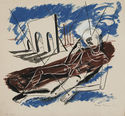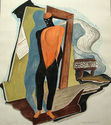
19th, 20th & 21st Century Fine Prints
707-546-7352 · fax 707-546-7924 · web: www.annexgalleries.com · email: artannex@aol.com
Ralph Alexander Chesse Biography
Ralph Alexander Chesse
American
1900–1991
Biography
Ralph Alexander Chessé, African-American actor, painter, muralist, printmaker, sculptor, and professional puppeteer, was born in New Orleans, Louisiana on January 6, 1900. Except for a few months of study at the School of the Art Institute of Chicago in 1918, Chessé was self-taught as an artist. By 1919, he had returned to New Orleans and worked as an actor, stage manager, and makeup artist at Le Petit Theatre, and the following year he held his first exhibition of his paintings.
Hoping to gain entry into the budding motion picture industry, Chessé moved to Hollywood, California in 1923. After working briefly on the United Artists lot as a timekeeper, he moved north to San Francisco in 1924. The following year he met the artist James Blanding Sloan, who introduced him to puppetry. He played in Sloan’s marionette show but was encouraged to start his own marionette production, which he did in 1927, and in 1929, he opened his own theatre, the Marionette Guild, on Merchant Street in San Francisco. Chessé returned to acting and designed sets for plays.
In 1934, Chessé was selected for the mural project at San Francisco’s Coit Tower. This was his first and only attempt at fresco painting. The following year he began work for the City of Paris department store making up marionette kits and demonstrating how to work them. The Federal Theatre was organized in 1935 and Chessé was appointed director of the puppetry division. The following year he was named State Director for California, which necessitated a move to Los Angeles. Chessé returned to San Francisco in 1939 and produced shows for the Federal Theatre at the Golden Gate International Exposition on Treasure Island.
He exhibited his paintings at the Gildea Gallery, and the Lucien Labaudt Gallery in San Francisco, and the Duncan Gallery in New York, and the Marc Antony Gallery in New Orleans. He was a member of the San Francisco Art Association and the Oakland Art Association. His work was included in exhibitions at the Oakland Art Gallery (now the Oakland Museum of California) and the de Young Museum, and a solo exhibition of his work was mounted at the San Francisco Museum of Modern Art.
Ralph Chessé died in Ashland, Oregon on March 17, 1991.
Exerpted from Chesse family records: http://www.chesseartsltd.com/family_history.html
"A Chessé arrived with Bienville in 1698 at the mouth of the Mississippi. Bienville was the one responsible for the original survey to determine where the city of New Orleans would be located. The ship's Manifest has a Michael Chessé listed as a freebooter (pirate). The Chessés arrived in the United States during the last half of the 18th century. Some came directly from France and some by way of Santo Domingo on the island of Cuba. After arriving in Louisiana they first settled in Pointe Coupe and built a sugar cane plantation where Joseph Alexander Chessé was born in 1802. He married (or lived with) a slave named Justine Olivier in 1830 and subsequently moved to New Orleans.
The plan for the development of New Orleans was laid out in 1721 so we know that the Chessés were instrumental in the building of New Orleans. The family house was built in 1830, at 1800 Burgundy on the corner of Kerleric off Esplanade. This was the heart of the French quarter in the Creole Faubourgs. It still stands today and can be found on the historical register. Ralph Chessé, 1900 -1990, and his siblings were born and raised there until the whole family moved to San Francisco in 1928. On the census records all the Chessés were listed as black. As happens in many mixed families some identified with the French white culture and some identified with the black culture and strengthened those genes. Chessés fought in black regiments during the civil war. Jim Crow split families and those that could pass as white did so.
Ralph Chessé’s family chose to identify with their French heritage and all married Caucasians. Florentine Chessé married Henri Alcard and their line is continued through the Bouttés of New Orleans who are an important part of the black community and are among other things international jazz musicians and greatly involved in the cultural life of New Orleans post Katrina.
Ralph Chessé always spoke with great affection of his boyhood in New Orleans and of the closeness of everyone that lived there. Much of what he paints is a reflection of families as well, and always expressing a distinct point of view. Of course, in San Francisco nothing was known of his African American heritage. The patriarchs of the Chessé family immigrated to Louisiana from France in the 1700s always considered themselves of French heritage irrespective of any intermarriage that occurred in 1830 which was before the Civil War and Jim Crow, when racial integration was not as frowned upon.
French chauvinism was the rule, it didn't matter what color you were. After the Civil War people had to chose which part of their heritage was to be emphasized as happened in the best Louisiana families many chose to “pass” as the lighter members of the Chessé family did. It was only in the late twentieth century that the family’s black American heritage was to be investigated and/or recognized. Interestingly enough, this ancestry was discovered by French relatives in Amiens, France who began tracing their history in the 1960s.








